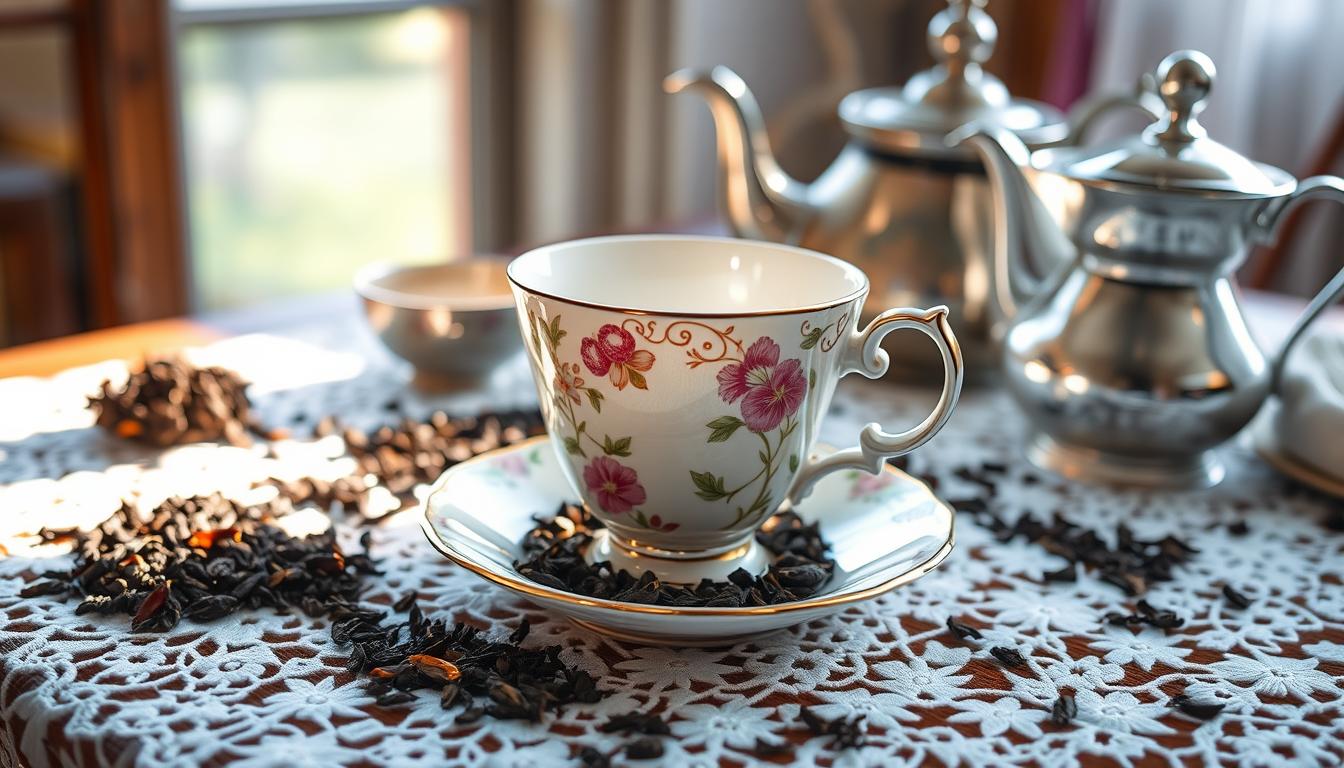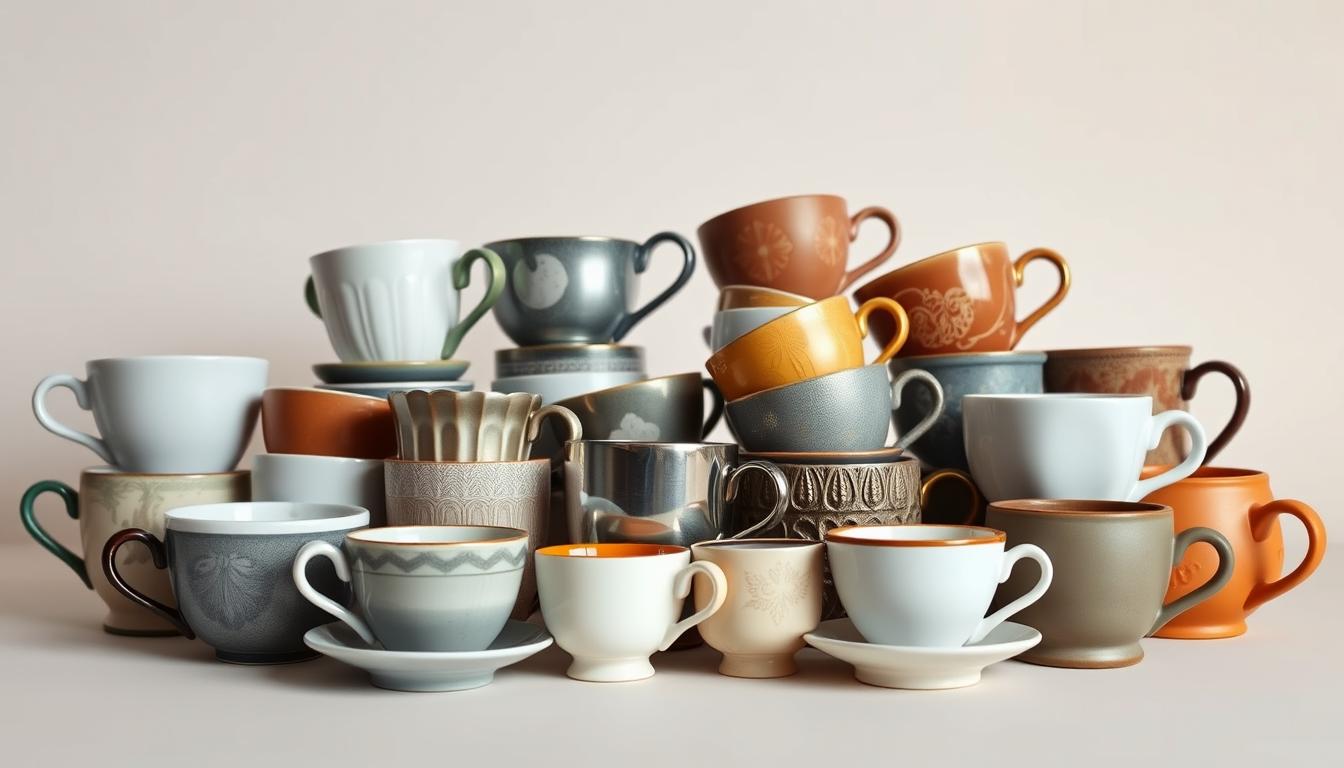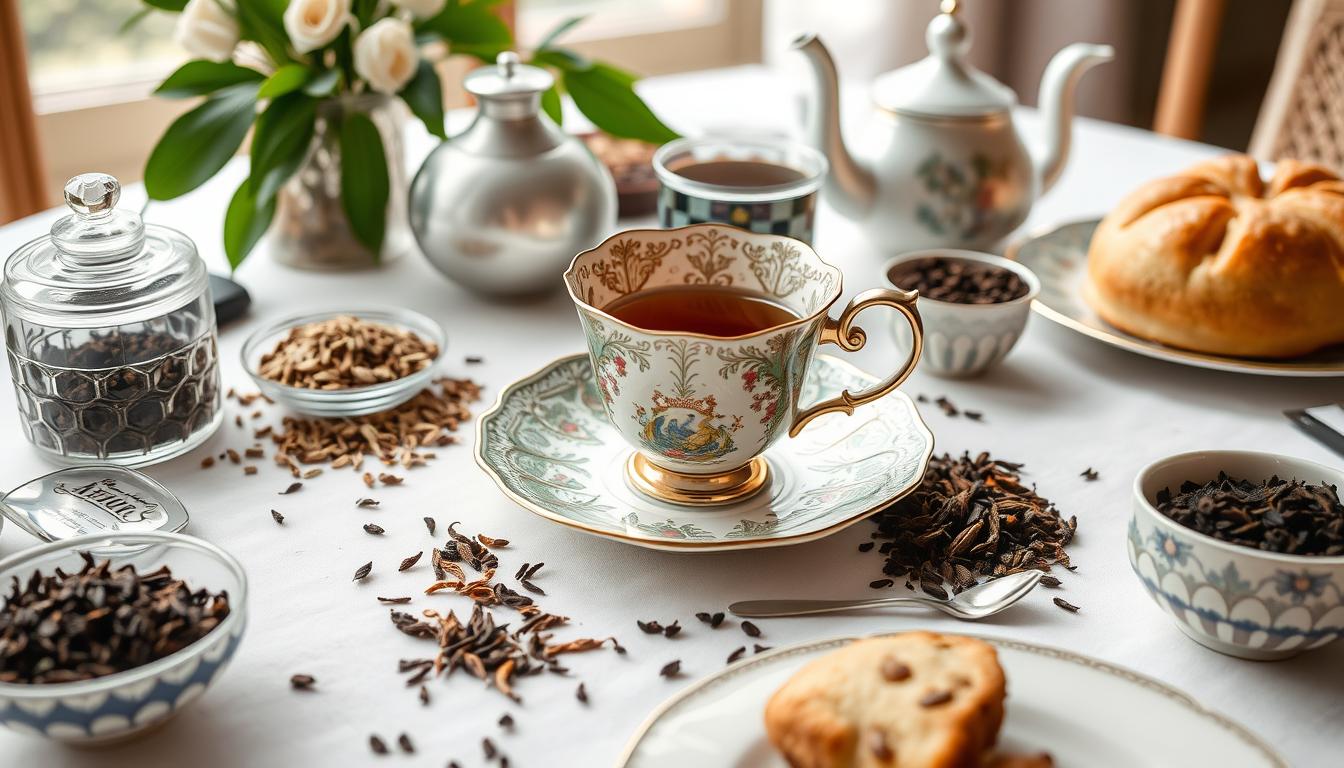In the world of tea, the teacup is key. It affects the taste, smell, and joy of drinking tea. From old Chinese teacups to new designs, the teacup is vital in tea culture.
Tea culture is rich in history and tradition. The teacup is at the heart of it. The right teacup makes tea drinking better. Whether you love tea or are just starting, knowing about teacups is important.
This guide explores teacups, their history, design, and role in tea culture. We’ll look at different materials, shapes, and sizes. You’ll learn how they change the tea experience. By the end, you’ll know how to pick the best teacup for your tea.
Key Takeaways
- Teacup importance is crucial in tea culture, influencing the flavor and aroma of tea.
- The right teacup can elevate the tea-drinking experience, making it more enjoyable and satisfying.
- Teacups come in different materials, shapes, and sizes, each with its own unique characteristics.
- Understanding the history and tradition of teacups is essential for appreciating their significance in tea culture.
- Choosing the perfect teacup depends on personal preference, tea type, and occasion.
- Teacup design and material can impact the temperature retention and flavor of tea.
Introduction: The Importance of the Teacup in Tea Culture
The teacup is key to enjoying tea, with its design and material affecting how tea tastes. A good teacup can make tea better, while a bad one can ruin it. The history of teacups is rich and varied, shaped by many cultures.
In tea brewing, the teacup is crucial. It helps control the steeping time, temperature, and how flavors and aromas come out. The teacup design can change how liquid flows, impacting the taste and smell of the tea. For example, a wide-mouthed teacup can let flavors out better, while a narrow one keeps aromas in.
Why the teacup matters in the tea-drinking experience
The teacup is more than just a container for tea. It’s a big part of the tea ritual. Choosing the right teacup can make or break the experience. Things like material, size, and shape all matter.

The history and evolution of the teacup
Teacups have a long history, starting in ancient China. Over time, many cultures have shaped the teacup, adding their own designs. Materials have changed too, showing off technological and cultural shifts.
Some notable teacup designs and their effects on tea brewing include:
- Chinese teacups, known for their delicate handles and intricate designs, which facilitate a precise pouring technique.
- Japanese teacups, characterized by their simplicity and minimalism, which emphasize the importance of the tea itself.
- English teacups, often adorned with ornate patterns and decorations, which reflect the country’s rich tea-drinking tradition.
In conclusion, the teacup is vital for enjoying tea. Its design and material greatly affect how tea is brewed and tasted. Knowing the history and role of the teacup in tea brewing helps tea lovers appreciate this important part of the tea ritual.
The Anatomy of a Teacup: Key Features and Design
The perfect brew depends on the teacup’s anatomy. The shape, size, handle, rim, and base all matter. Teacup materials like porcelain are chosen for their durability and heat retention. The right teacup shape and size help tea leaves unfurl and release flavors.
A good teacup has a comfy handle, smooth rim, and stable base. The handle should fit well in your hand. The rim should be thin and smooth to avoid lip scratches. The base should be heavy to prevent spills. 
Understanding the Shape and Size
The teacup’s shape and size impact your tea’s taste and aroma. Larger teacups let more tea leaves unfurl, enhancing flavors and aromas. Smaller teacups concentrate these, offering a more intense experience. Porcelain teacups are best for delicate teas, preserving subtle flavors and aromas.
The Role of the Handle, Rim, and Base
The handle, rim, and base are crucial for comfort and function. A comfy handle makes holding the teacup easy. A smooth rim prevents lip scratches. A stable base keeps the teacup steady, making tea time enjoyable. Choosing the right teacup materials and design improves your tea experience.
Materials Matter: Choosing the Right Teacup for Your Tea
Choosing the right teacup is key for a great tea ceremony. The material of the teacup affects the tea’s temperature, flavor, and aroma. With options like porcelain, ceramic, glass, and more, picking the best one can be tough.
The size of the teacup is also important. Different sizes can change how the tea tastes and smells. For example, small teacups are good for delicate teas, while big ones are better for stronger teas.
Exploring Different Materials
Porcelain teacups are popular for tea ceremonies because they keep heat well without changing the tea’s flavor. Ceramic teacups are better for stronger teas. Glass teacups let you see the tea, making it a great choice too.
How Material Impacts Temperature Retention and Tea Flavor
The material of the teacup affects how long it keeps the tea warm and how it tastes. For example, porcelain keeps heat longer, while ceramic lets the tea cool faster. Knowing how materials affect your tea can help you pick the right teacup.
Which Material is Best for Different Types of Tea
The type of tea you’re serving can guide your choice of teacup material. Delicate teas like green or white tea are best in porcelain teacups. Hearty teas like black or oolong tea are better in ceramic teacups. The right teacup can make your tea experience even better.
| Teacup Material | Temperature Retention | Tea Flavor |
|---|---|---|
| Porcelain | Excellent | Delicate |
| Ceramic | Good | Heartier |
| Glass | Fair | Neutral |
The Perfect Size: How to Choose the Right Teacup
Choosing the right teacup is key for tea lovers. Traditional teacups are popular, but size matters too. A small teacup can make tea taste bitter, while a big one can make it weak.
Knowing the standard sizes is important. This helps pick the perfect teacup for your tea and the occasion.
Understanding Standard Teacup Sizes
Teacup sizes range from 6 to 12 ounces. The 8-ounce size is most common and works well for many teas. For one person, a 6-ounce teacup is best. For groups, 10 or 12 ounces is better.
Traditional teacups are often smaller and more delicate. They’re great for special events.
Matching Teacup Size with Brewing Style and Occasion
Think about your brewing style and the occasion when choosing a teacup. Delicate teas like green or white need smaller cups. Bigger cups are better for stronger teas like black or oolong.
Also, consider the event. Traditional teacups are for formal events. Modern styles are for casual get-togethers.
In conclusion, picking the right teacup size is crucial. By knowing the standard sizes and matching them to your brewing style and occasion, you can enjoy the perfect tea every time.
Teacup Styles: From Traditional to Modern
Teacup styles vary widely, showing the diversity of cultures and tastes. They reflect both beauty and practical needs, shaped by history. The design of a teacup can change how we enjoy tea, with handles and design impacting comfort.
Classic teacup designs reveal the rich traditions of tea drinking worldwide. English teacups are famous for their fine handles and detailed patterns. Chinese teacups stand out with their vibrant colors and symbols. Japanese teacups, meanwhile, are known for their simple beauty and use of natural materials.
Exploring Traditional and Modern Teacup Designs
Some traditional teacup designs include:
- English: delicate handles, intricate designs, and ornate patterns
- Chinese: bold colors, motifs, and symbolic designs
- Japanese: minimalist aesthetic, emphasis on simplicity, and natural materials
Modern teacups, however, focus on comfort and new designs. They often have ergonomic handles and bold colors. This makes for a unique and enjoyable tea experience.
The style of a teacup greatly affects our tea experience. It’s important to pick a teacup that fits our taste and needs.
| Teacup Style | Characteristics | Influence on Tea-Drinking Experience |
|---|---|---|
| Traditional English | Delicate handles, intricate designs | Enhances comfort and elegance |
| Modern Minimalist | Ergonomic handles, sleek lines | Improves functionality and comfort |
Teacup Handles: Why They Matter for Comfort and Function
The teacup handle is key in tea etiquette, often overlooked but vital. A good handle makes holding the cup comfortable and easy. It lets you enjoy your tea without any hassle.
The handle’s design affects how you hold and pour the tea. For example, big handles are great for passing cups in tea ceremonies. Small handles are better for drinking alone.
The Importance of Handle Design
Teacup handles vary a lot, depending on culture and style. Some are big and fancy, others small and simple. The design reflects the cup’s use and the user’s taste.
Cultural Significance of Handle Design
In some cultures, the handle is more than just a part of the cup. It’s a symbol of tradition and heritage. For instance, in Japanese tea ceremonies, the handle is small and elegant, showing Japanese simplicity and beauty.
The handle’s design also shapes how we hold and pour tea. Big handles are good for passing cups, while small ones are better for personal use. Knowing about handle designs helps us understand tea etiquette and techniques better.
How to Drink Tea: Teacup Etiquette and Techniques
Drinking tea from a teacup is an art that needs attention to detail. It also requires a deep understanding of cultural traditions. Holding a teacup correctly is key for comfort and style. It makes the tea-drinking experience better.
Regular teacup care and maintenance help keep the teacup in good condition. This way, it can be enjoyed for many years.
When holding a teacup, consider a few important things. The handle should be between your thumb and index finger, with your middle finger supporting the bottom. This makes holding the teacup comfortable and secure. It’s crucial for teacup care and maintenance.
Drinking from a teacup can vary by culture. Some cultures value silence and reverence, while others enjoy lively conversations.
Here are some tips for teacup etiquette:
- Hold the teacup correctly, with the handle between the thumb and index finger
- Avoid touching the rim of the cup with your lips
- Keep the teacup at a comfortable distance from your body
- Be mindful of your posture and body language while drinking tea
By following these guidelines and focusing on teacup care and maintenance, you can improve your tea-drinking experience. You’ll also gain a deeper appreciation for the cultural significance of the teacup. Whether you’re alone or with friends, drinking tea from a teacup brings joy and peace.
Caring for Your Teacup: Cleaning and Maintenance Tips
To keep your teacup in top shape, regular cleaning and care are key. This is especially true for tea ceremonies, where the teacup’s cultural value is high. Taking good care of your teacup will keep it in great condition for years.
Cleaning your teacup depends on its material. For delicate porcelain, use a soft cloth and mild soap to avoid scratches. Ceramic teacups can handle a bit more cleaning but still need gentle care to avoid chipping.
Storage and Maintenance Tips
- Store teacups in a cool, dry place to prevent moisture buildup.
- Avoid stacking teacups to prevent chips and cracks.
- Regularly dust teacups to prevent the accumulation of dust and stains.
By following these simple tips, your teacup will stay in excellent condition. It will be ready for any tea ceremonies or daily tea time, showing the cultural importance of this tradition.
Why Maintenance Matters
Regular maintenance is vital for keeping your teacup in top condition. It prevents stains and residue, making your tea-drinking experience better. Whether for tea ceremonies or a quiet tea moment, a well-maintained teacup is essential.
Teacups in Tea Ceremonies and Traditions
Teacups are key in tea ceremonies, showing hospitality, respect, and community. They are a big part of the ritual, with designs and materials showing the culture’s values. For example, antique teacups are loved by teacup collectors for their beauty and history.
In Chinese tea ceremonies, teacups are small and detailed, filled to the top for abundance. Japanese tea ceremonies use simple, rustic teacups, focusing on natural looks. They serve matcha, a green tea powder, in a special ceremony.
The English tea ceremony is formal, with teacups made of fine porcelain and fancy designs. They serve teas like Earl Grey and English Breakfast. In China, Japan, or England, teacups are key, showing hospitality and respect.
The Cultural Significance of Teacups
- Symbolism of hospitality and respect
- Representation of cultural values and aesthetics
- Importance in traditional tea ceremonies and rituals
In conclusion, teacups are vital in tea ceremonies, showing a culture’s values and beauty. Whether you collect teacups or just love tea, they are a beautiful symbol of the tea experience.
Teacup Collecting: A Hobby for Tea Lovers
Collecting teacups is a fun hobby for those who love tea. It combines a passion for tea, history, and beauty. Finding rare teacups and displaying them is a big part of the fun. The right teacup can make your tea taste even better, enhancing the experience.
To start your collection, do some research. Look for antique teacups at estate sales and auctions. Think about the material, design, and condition. Also, consider how well it will match your favorite teas.
- Set a budget and stick to it
- Learn about different materials and their characteristics
- Join online communities or forums to connect with other collectors
When buying teacups, look for unique designs and rare materials. The right teacup can change how you enjoy your tea. It’s a fun way to try different teas and find new favorites.
Teacup collecting is a hobby that combines love of tea, history, and beauty. With the right knowledge, you can start your own collection. Enjoy the thrill of finding new teacups and trying different teas.
| Teacup Material | Characteristics | Pairing Suggestions |
|---|---|---|
| Porcelain | Delicate, translucent | Delicate teas, such as green tea or white tea |
| Ceramic | Earthy, rustic | Hearty teas, such as black tea or herbal tea |
Teacup Pairings: Matching Your Teacup with the Right Tea
Finding the perfect match between a teacup and tea can make your tea time even better. It brings out the best in both the flavors and the aroma. Choosing the right teacup for your favorite tea is an art that can change how you enjoy it.
Harmonizing Design and Material
The design and material of your teacup can either match or contrast with your tea. For example, delicate teas like floral ones look great in fine porcelain. On the other hand, strong teas do well in sturdy ceramic.
By matching the teacup’s features with your tea’s profile, you create a perfect pair. This makes the tea-drinking ritual even more enjoyable.
Pairing for Optimal Enjoyment
Whether you love the light taste of Darjeeling or the bold taste of Assam, there’s a teacup for you. Understanding the tea and the teacup can make your tea time truly special. Each sip becomes a moment of pure joy.

